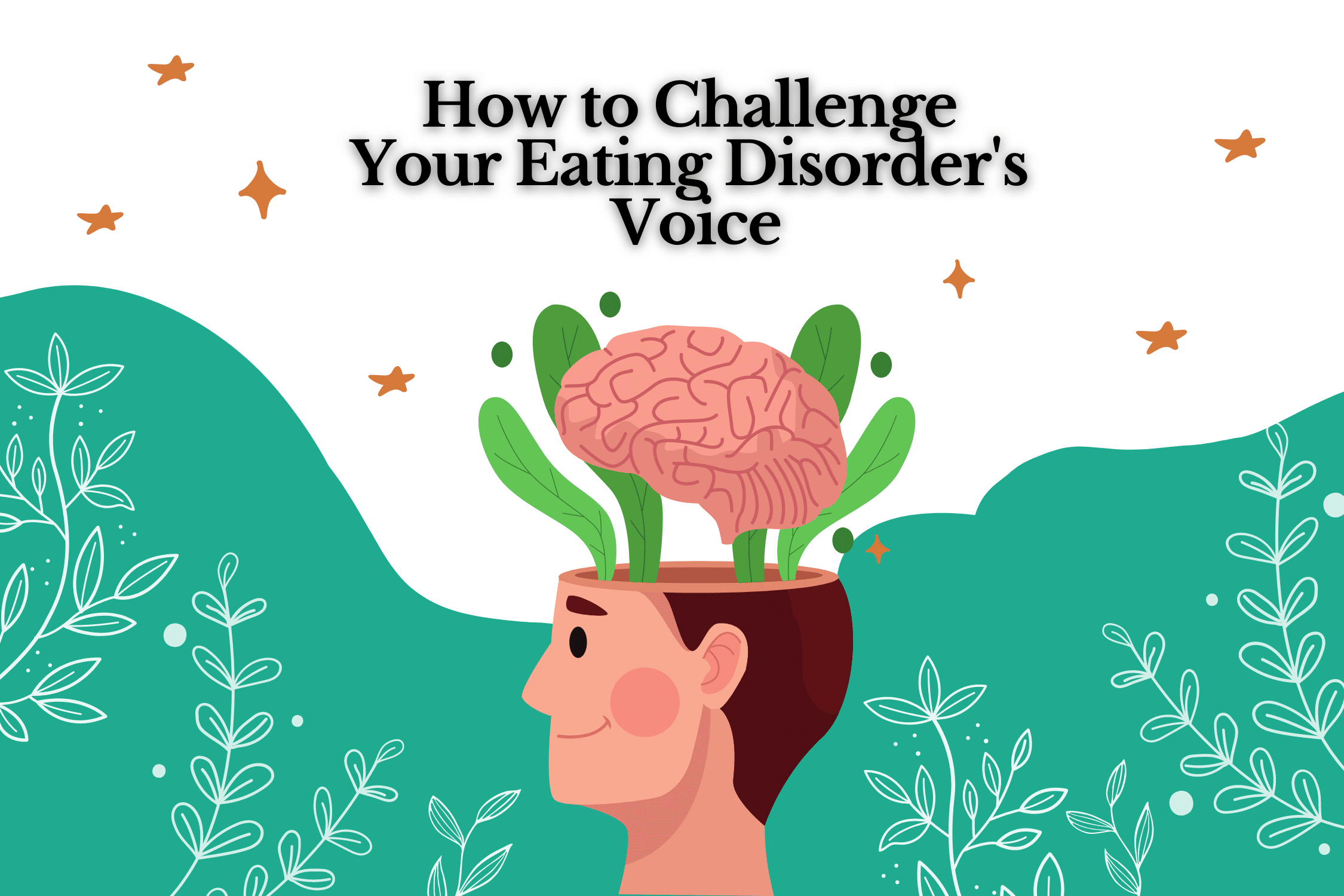One of the most challenging parts of recovery for many people is separating themselves from their eating disorder and, more specifically, hearing their own voice – instead of the mean, manipulative voice of their eating disorder.
A big part of our client’s recovery process is realizing that they aren’t their eating disorders. For the longest time, it can feel like you are your eating disorder, and your eating disorder is you. There can be a feeling that it’s the most important part of your identity. And in worse cases, you don’t know who you are without it; you may forget who you were before your eating disorder latched onto you.
When dealing with an eating disorder, you can feel defeated because the voice emphasizes everything you’re going through. This voice tells you that you’re not good enough and not worthy, making you believe what it says. It shames you for eating, and it shames your body. As your condition worsens, the more powerful this voice becomes. Think of talking about your eating disorder, like being with an abusive partner- because it is.
At Eating Disorder Solutions, we teach you to separate these two voices, your voice, and the
eating disorder voice. If the eating disorder talks to you, you will have coping mechanisms to oppose it, challenge it, and disobey its commands. We help you learn to take control of your life; after all – it’s your life, not the eating disorder’s.
The Voice of an Eating Disorder
We all have thoughts and beliefs that are harmful, problematic, and distressing for various reasons throughout our lives. It is possible, however, for these thoughts and beliefs to become automatic and habitual over time, evolving into an eating disorder. Under those circumstances, challenging your eating disorder voice’s negative messages becomes an essential piece you must tackle to achieve and maintain a successful recovery.
Unfortunately, your eating disorder voice has learned how you think, so it can disguise itself using persuasive tactics and tones. The eating disorder voice may present as:
- Promising: “If you just go to the gym for a couple of hours each day, you can have your coffee with sugar.”
- Persuasive: “If you’re thinner, people will like you more. You won’t have to try so hard to fit in.”
- Fear: “You will be fat if you don’t watch your calories.”
- Self-Criticism: “You’re lazy and undisciplined. I can’t believe you ordered that. That is way too much food; everyone will judge you.”
- Translations: ‘“When they say you look healthy, they really mean “look how much weight you’ve gained.”’
- Denial: “I don’t have a problem; most people are way worse than me.”
These are just a few examples of negative messages that your eating disorder can give you, and they can grow into severe, debilitating ones if you allow them. They can distort your thoughts about food, nutrition, and your body. You may end up eating and exercising in a way that can harm your mental and physical well-being. As a result of these messages, you may restrict your food intake, binge eat, purge, over-exercise, or isolate yourself from others, which is substantially worse for you. You need help in times like these.
An important recovery goal is to begin noticing and keeping yourself aware of these harmful thoughts – because initially, whenever you stop disordered eating and exercising behaviors, the voice of your eating disorder can become louder. For this reason, you must learn how to identify unhelpful thought patterns and distorted thoughts to combat this and keep your own voice as a priority.
Recognizing Unhelpful Thought Patterns
It may surprise you, but keeping the eating disorder voice in check does not mean eradicating it completely. Instead, the goal is to recognize the eating disorder voice for what it is, an abusive partner, and reframe the eating disorder thought into something new.
Black and White Thinking or Polarized Thinking: Thinking in terms of all or nothing; good or bad; right or wrong; yes or no. A gray area or middle ground does not exist. As a result, we cannot see circumstances objectively or moderately. Example: You think, “only organic foods are healthy.” Therefore, you only eat what’s in your friend’s house if organic foods are available.
Overgeneralization: Drawing conclusions based on a single incident or piece of evidence. To predict the future, you rely on the events of the past and the experiences you’ve had. When it happens once, you assume it will occur again and again. If you are using “always,” “never,” and “every,” you are overgeneralizing. Example: “I binged last night – I will never recover from my eating disorder.”
Catastrophizing: This is when people tend to blow everything out of proportion. You notice a problem and ask yourself, “What if…?” What if tragedy strikes? What if it happens to you? Example: You are out for dinner with friends, and in addition to what you ordered, you want a taste of what your friends are eating. Before doing it, you think, “What if I can’t stop eating after I take a bite? What if I start taking a bite from everyone else’s plate?”
Labeling or Mislabeling: In this case, overgeneralization is at its extreme. This means we make global statements about ourselves and others based on situational behavior rather than hard facts. We evaluate and judge ourselves and others after one experience or incident. Example: You label yourself as “stupid” or “loser” when you make a mistake instead of saying, “I made a mistake.”
Emotional Reasoning: When you interpret reality according to how you’re feeling at the time, you use that feeling as a basis for interpretation. You perceive and analyze situations based on feelings rather than facts. Because your mood affects your perception of the world, you cannot see clearly. Example: “I feel nervous and fearful about going to treatment. It must be true that it won’t work for me.”
It’s easy to see that unhelpful thinking patterns can take many forms. But, once you become aware and identify these thoughts and beliefs, you can challenge and change them. So, how can you start doing that today?
Silencing Your Eating Disorder Voice and Finding Your Recovery Voice
When you stop using disordered eating habits, you may feel anxious and uncomfortable because you used them to cope with difficult situations and emotions. Imagine, however, that you want to avoid reverting to disordered behaviors in unfamiliar and stressful situations.
It’s important for everyone suffering to know they have a choice about whether or not to listen to those voices. No matter what they say, you do not have to listen to them. Remember that they only lie to you, and you can stand up to them. The more you do so, the weaker they become. It is not easy to go against those voices, but you do have the power within yourself to do it.
Once you are aware of your thoughts, you can work towards change. One technique is to externalize these thoughts and label them “ED” thoughts. When you label these thoughts, you can gain distance from them, helping you recognize and challenge them. For example, you may think, “I can’t eat carbs, or I will gain weight.” Transform this statement into an eating disorder statement, rephrasing it: “My eating disorder is telling me not to eat carbs – not me.”
Reframe, Rethink, Retrain:
Reframing or rethinking is a cognitive-behavioral technique that challenges and changes dysfunctional beliefs and thoughts. Among many other therapy modalities, we can help you reframe these thoughts using Dialectical Behavior Therapy (DBT) and Cognitive Behavioral Therapy (CBT) – these are life-changing tools if you’re willing to work to succeed with them. Here are some simple steps to begin with:
Become aware of your limited thinking patterns. Challenge the limited thinking patterns. Ask yourself:
- Does the thought have any basis in reality? Is it a fact?
- What is its purpose? Is it destructive or productive?
Now, consider other ways of thinking. Once you’ve determined your thought pattern is limited, you can create alternative approaches:
- Come up with at least 2-3 alternative thoughts.
- Pick one alternative thought and test it.
- Apply the thought that seems most productive.
- Practice replacing limited thoughts with new ones.
Watch out for old thinking patterns that creep back into your life.
Another coping mechanism to include in your arsenal against ED’s voice is STOP-ping and ACCEPT-ance.
STOP stands for:
S – Stop: Freeze and stop what you’re doing.
T – Take a step back: Take a moment to breathe deeply.
O – Observe: Take note of the situation, including what others are doing and how you feel.
P – Proceed: Decide how you want to proceed.
ACCEPTS stands for:
A – Activities: Engage in simple, distracting activities. You could walk, color a picture, or do the dishes.
C – Contributing: Do something for others. An act as small as hugging someone or as large as volunteering can make a difference.
C – Comparison: Reflect on where you were before recovery and how far you’ve come.
E – Emotions: Listen to a song that makes you happy or watch a funny movie to elicit a new emotion in yourself.
P – Pushing Away: Set the intrusive thought aside for now. Some people visualize putting it into a box. You won’t avoid it; you’ll just be calmer when you return to it.
T – Thoughts: You can distract yourself with thoughts, just as you can with activities. Consider counting something, talking to someone, or singing a song to divert your attention away from disordered eating.
S – Sensations: Experiencing something good for your body is important. Take a hot bath, enjoy a fragrant lavender scent, or walk barefoot in the grass.
Developing automatic thoughts that are beneficial to you takes time and practice. At first, changing these thoughts and beliefs will be challenging. But, after some time, you will rewire your brain’s neural network to adopt new, healthy thinking patterns.
A Toolbox of Responses
In the case of eating disorders, it is perfectly understandable why people struggle to develop self-esteem and find the motivation to push forward every day. You can’t help but believe what you hear when such negative voices berate you constantly.
As you recover from an ED, you will learn how to respond to various situations differently. Multiple therapies are used in these interventions and can be viewed as the contents of a toolbox, which are all at your disposal – and you get to hold the power of which tools to use when an eating disorder thought arises.
Recovery from eating disorders is not linear and takes time. Be patient and gentle with yourself. Practice kindness and self-compassion. You are brave and determined to face these thoughts, which shows strength. Remember to recognize that.
If you’re struggling with your eating, you’re not alone. It’s okay to need more support, to reach out for help to ask for what you need. When emotions and thoughts overwhelm you, your eating disorder will provide comfort, when in reality, it’s a trap that leads to relapse. You don’t need that right now or at any time. So instead, eat, nourish your body, rest, relax, and seek support.
Call us today at 855-808-4213 or contact us online to learn more about our treatment options and how we can help you differentiate between the eating disorder voice and your own empowering, strong, and resilient voice.



